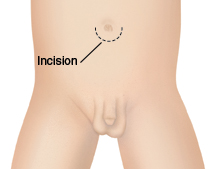Pediatric Hernia Surgery: Umbilical Hernia Repair
Pediatric Hernia Surgery: Umbilical Hernia Repair
Hernias in children are common. They’re caused by an abdominal wall defect that is present at birth. Most often, the hernia forms in the groin or umbilical area. It can usually be felt as a bulge under the skin. Childhood hernias can be safely repaired using outpatient (same-day) surgery. Best of all, most children recover quickly with only minor discomfort.
Questions you may have
It’s normal to have concerns about your child’s surgery. Here are answers to some common questions:
Is surgery safe? Yes. Complications from hernia surgery are rare. In fact, most children get back to normal in a very short time.
Will my child be in pain during surgery? No. Your child will be given medicines that make him or her sleep during surgery. Some mild discomfort after the operation is normal.
Is surgery always needed? Umbilical hernias in infants may get better without surgery. But repairing an umbilical hernia is safer than leaving it untreated.
Preparing your child for surgery
Follow your healthcare provider's advice to help get your child ready for surgery. You may be asked to:
Tell the healthcare provider about any medicines your child takes, including children’s pain relievers.
Accompany your child during tests. These may include urine and blood tests.
Follow any directions your child is given for taking medicines and for not eating or drinking before surgery.
The day of surgery
You’ll meet with the anesthesiologist or nurse anesthetist. He or she will talk with you about the anesthesia used to prevent pain during surgery. Your child will be given an intravenous (IV) line to provide fluids and medicines. This may happen in the operating room while your child is receiving mask anesthesia so he or she sleeps during the surgery. The type of surgery your child has depends on the location of the hernia. If your child has a related problem, such as an undescended testicle, it may also be repaired at the same time as the hernia.
Repairing an umbilical hernia
A semicircular incision is made under the navel. Any protruding tissue is pushed back into place and the hernia sac is removed. The abdominal wall is then closed with sutures.
Your child’s recovery
Your child can likely go home the same day as surgery. Don’t worry if you notice some swelling or bruising. This is normal and should go away in a short time. To help speed recovery, encourage your child to move around. But children should avoid rough play for about a week. After that, it’s OK to let them get back to doing things they enjoy. If you have questions or concerns, be sure to talk with the healthcare provider during follow-up visits.
Risks and complications
Hernia surgery for children is safe, but does have some risks. These include:
Bleeding
Infection
Inability to urinate
Risk the hernia will happen again
Bowel or bladder injury
Anesthesia risks
No bowel movements
When to call your child's healthcare provider
After surgery, call your child's healthcare provider if your child has any of the following:
A large amount of swelling or bruising
Fever of 100.4°F (38°C) or higher, or as directed by your child's healthcare provider
Increasing redness or drainage of the incision
Bleeding
Increasing pain
Nausea or vomiting
Updated:
March 21, 2017
Sources:
Care of the umbilicus and management of umbilical disorders. UpToDate, Wound infections following abdominal wall hernia repair: Epidemiology, pathogenesis, and prevention. UpToDate
Reviewed By:
Freeborn, Donna, PhD, CNM, FNP,Image reviewed by StayWell medical illustration team.,Lehrer, Jenifer, MD
